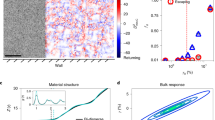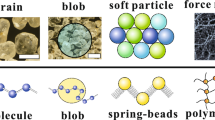Abstract
Many seemingly different soft materials—such as soap foams, mayonnaise, toothpaste and living cells—display strikingly similar viscoelastic behaviour. A fundamental physical understanding of such soft glassy rheology and how it can manifest in such diverse materials, however, remains unknown. Here, by using a model soap foam consisting of compressible spherical bubbles, whose sizes slowly evolve and whose collective motion is simply dictated by energy minimization, we study the foam’s dynamics as it corresponds to downhill motion on an energy landscape function spanning a high-dimensional configuration space. We find that these downhill paths, when viewed in this configuration space, are, surprisingly, fractal. The complex behaviour of our model, including power-law rheology and non-diffusive bubble motion and avalanches, stems directly from the fractal dimension and energy function of these paths. Our results suggest that ubiquitous soft glassy rheology may be a consequence of emergent fractal geometry in the energy landscapes of many complex fluids.
This is a preview of subscription content, access via your institution
Access options
Subscribe to this journal
Receive 12 print issues and online access
$259.00 per year
only $21.58 per issue
Buy this article
- Purchase on Springer Link
- Instant access to full article PDF
Prices may be subject to local taxes which are calculated during checkout




Similar content being viewed by others
References
Liu, A. J. & Nagel, S. R. Nonlinear dynamics: jamming is not just cool any more. Nature 396, 21–22 (1998).
Gopal, A. & Durian, D. Relaxing in foam. Phys. Rev. Lett. 91, 188303 (2003).
Fabry, B. et al. Scaling the microrheology of living cells. Phys. Rev. Lett. 87, 148102 (2001).
Bursac, P. et al. Cytoskeletal remodelling and slow dynamics in the living cell. Nature Mater. 4, 557–561 (2005).
Deng, L. et al. Fast and slow dynamics of the cytoskeleton. Nature Mater. 5, 636–640 (2006).
Hoffman, B. D., Massiera, G., Van Citters, K. M. & Crocker, J. C. The consensus mechanics of cultured mammalian cells. Proc. Natl Acad. Sci. USA 103, 10259–10264 (2006).
Hoffman, B. D. & Crocker, J. C. Cell mechanics: dissecting the physical responses of cells to force. Annu. Rev. Biomed. Eng. 11, 259–288 (2009).
Tambe, D. T. et al. Collective cell guidance by cooperative intercellular forces. Nature Mater. 10, 469–475 (2011).
Parry, B. R. et al. The bacterial cytoplasm has glass-like properties and is fluidized by metabolic activity. Cell 156, 183–194 (2014).
Chen, D. T., Wen, Q., Janmey, P. A., Crocker, J. C. & Yodh, A. G. Rheology of soft materials. Condens. Matter Phys. 1, 301–322 (2010).
Sollich, P., Lequeux, F., Hébraud, P. & Cates, M. E. Rheology of soft glassy materials. Phys. Rev. Lett. 78, 2020–2023 (1997).
Sollich, P. Rheological constitutive equation for a model of soft glassy materials. Phys. Rev. E 58, 738–759 (1998).
Hébraud, P. & Lequeux, F. Mode-coupling theory for the pasty rheology of soft glassy materials. Phys. Rev. Lett. 81, 2934–2937 (1998).
Sollich, P. & Cates, M. E. Thermodynamic interpretation of soft glassy rheology models. Phys. Rev. E 85, 031127 (2012).
Caspi, A., Granek, R. & Elbaum, M. Enhanced diffusion in active intracellular transport. Phys. Rev. Lett. 85, 5655–5658 (2000).
Gopal, A. & Durian, D. Nonlinear bubble dynamics in a slowly driven foam. Phys. Rev. Lett. 75, 2610–2613 (1995).
Durian, D., Weitz, D. & Pine, D. Multiple light-scattering probes of foam structure and dynamics. Science 252, 686–688 (1991).
Tewari, S. et al. Statistics of shear-induced rearrangements in a two-dimensional model foam. Phys. Rev. E 60, 4385–4396 (1999).
Zargar, R., Nienhuis, B., Schall, P. & Bonn, D. Direct measurement of the free energy of aging hard sphere colloidal glasses. Phys. Rev. Lett. 110, 258301 (2013).
Yoshino, H. & Zamponi, F. Shear modulus of glasses: results from the full replica-symmetry-breaking solution. Phys. Rev. E 90, 022302 (2014).
DeGiuli, E., Lerner, E. & Wyart, M. Theory of the jamming transition at finite temperature. J. Chem. Phys. 142, 164503 (2015).
Ono, I. K., Tewari, S., Langer, S. A. & Liu, A. J. Velocity fluctuations in a steadily sheared model foam. Phys. Rev. E 67, 061503 (2003).
Rainone, C., Urbani, P., Yoshino, H. & Zamponi, F. Following the evolution of hard sphere glasses in infinite dimensions under external perturbations: compression and shear strain. Phys. Rev. Lett. 114, 015701 (2015).
Wyart, M. Marginal stability constrains force and pair distributions at random close packing. Phys. Rev. Lett. 109, 125502 (2012).
Lerner, E., Düring, G. & Wyart, M. Low-energy non-linear excitations in sphere packings. Soft Matter 9, 8252–8263 (2013).
Biroli, G. & Urbani, P. Breakdown of elasticity in amorphous solids. Preprint at http://arxiv.org/abs/1601.06724 (2016).
O’Hern, C. S., Langer, S. A., Liu, A. J. & Nagel, S. R. Random packings of frictionless particles. Phys. Rev. Lett. 88, 075507 (2002).
O’Hern, C. S., Silbert, L. E., Liu, A. J. & Nagel, S. R. Jamming at zero temperature and zero applied stress: the epitome of disorder. Phys. Rev. E 68, 011306 (2003).
Manning, M. L. & Liu, A. J. Vibrational modes identify soft spots in a sheared disordered packing. Phys. Rev. Lett. 107, 108302 (2011).
Cubuk, E. D. et al. Identifying structural flow defects in disordered solids using machine-learning methods. Phys. Rev. Lett. 114, 108001 (2015).
Wijtmans, S. & Manning, M. L. Disentangling defects and sound modes in disordered solids. Preprint at http://arxiv.org/abs/1502.00685 (2015).
Lin, J., Saade, A., Lerner, E., Rosso, A. & Wyart, M. On the density of shear transformations in amorphous solids. Europhys. Lett. 105, 26003 (2014).
Lin, J. & Wyart, M. Mean-field description of plastic flow in amorphous solids. Phys. Rev. X 6, 011005 (2016).
Durian, D. Foam mechanics at the bubble scale. Phys. Rev. Lett. 75, 4780–4783 (1995).
Durian, D. Bubble-scale model of foam mechanics: Melting, nonlinear behavior, and avalanches. Phys. Rev. E 55, 1739–1751 (1997).
Stevenson, P. Inter-bubble gas diffusion in liquid foam. Curr. Opin. Colloid Interface Sci. 15, 374–381 (2010).
Massen, C. P. & Doye, J. P. Power-law distributions for the areas of the basins of attraction on a potential energy landscape. Phys. Rev. E 75, 037101 (2007).
Charbonneau, P., Kurchan, J., Parisi, G., Urbani, P. & Zamponi, F. Fractal free energy landscapes in structural glasses. Nature Commun. 5, 3725 (2014).
Feitosa, K., Halt, O. L., Kamien, R. D. & Durian, D. Bubble kinetics in a steady-state column of aqueous foam. Europhys. Lett. 76, 683–689 (2006).
Bitzek, E., Koskinen, P., Gähler, F., Moseler, M. & Gumbsch, P. Structural relaxation made simple. Phys. Rev. Lett. 97, 170201 (2006).
Durian, D., Weitz, D. & Pine, D. Scaling behavior in shaving cream. Phys. Rev. A 44, R7902 (1991).
Shlesinger, M., West, B. & Klafter, J. Lévy dynamics of enhanced diffusion: application to turbulence. Phys. Rev. Lett. 58, 1100–1103 (1987).
Mantegna, R. N. & Stanley, H. E. Stochastic process with ultraslow convergence to a Gaussian: the truncated lévy flight. Phys. Rev. Lett. 73, 2946–2949 (1994).
Weeks, E. R., Crocker, J. C., Levitt, A. C., Schofield, A. & Weitz, D. A. Three-dimensional direct imaging of structural relaxation near the colloidal glass transition. Science 287, 627–631 (2000).
Lau, A. W., Hoffman, B. D., Davies, A., Crocker, J. C. & Lubensky, T. C. Microrheology, stress fluctuations, and active behavior of living cells. Phys. Rev. Lett. 91, 198101 (2003).
Crocker, J. C. & Hoffman, B. D. Multiple-particle tracking and two-point microrheology in cells. Methods Cell Biol. 83, 141–178 (2007).
Zhou, M. A new look at the atomic level virial stress: on continuum-molecular system equivalence. Proc. R. Soc. A 459, 2347–2392 (2003).
Mason, T. G. Estimating the viscoelastic moduli of complex fluids using the generalized Stokes–Einstein equation. Rheol. Acta 39, 371–378 (2000).
Dasgupta, B. R., Tee, S.-Y., Crocker, J. C., Frisken, B. & Weitz, D. Microrheology of polyethylene oxide using diffusing wave spectroscopy and single scattering. Phys. Rev. E 65, 051505 (2002).
Weeks, E. R. & Swinney, H. L. Anomalous diffusion resulting from strongly asymmetric random walks. Phys. Rev. E 57, 4915–4920 (1998).
Maloney, C. E. & Lemaître, A. Amorphous systems in athermal, quasistatic shear. Phys. Rev. E 74, 016118 (2006).
Risken, H. Fokker-Planck Equation (Springer, 1984).
Crocker, J. C. & Grier, D. G. Microscopic measurement of the pair interaction potential of charge-stabilized colloid. Phys. Rev. Lett. 73, 352–355 (1994).
Combe, G. & Roux, J.-N. Strain versus stress in a model granular material: a devil’s staircase. Phys. Rev. Lett. 85, 3628–3631 (2000).
Van Hecke, M. Jamming of soft particles: geometry, mechanics, scaling and isostaticity. J. Phys. Condens. Mater. 22, 033101 (2010).
Ashwin, S., Blawzdziewicz, J., O’Hern, C. S. & Shattuck, M. D. Calculations of the structure of basin volumes for mechanically stable packings. Phys. Rev. E 85, 061307 (2012).
Mantegna, R. N. & Stanley, H. E. Scaling behaviour in the dynamics of an economic index. Nature 376, 46–49 (1995).
Acknowledgements
Special thanks to A. J. Liu, D. J. Durian, E. R. Weeks, J. Sethna, C. P. Goodrich and J. Lin for useful discussions. H.J.H. acknowledges support from US Department of Education GAANN Fellowship P200A120246.
Author information
Authors and Affiliations
Contributions
J.C.C. and R.A.R. designed the study. H.J.H. performed the study, analysed the data and prepared the figures. J.C.C., R.A.R. and H.J.H. interpreted the data, and wrote the paper.
Corresponding authors
Ethics declarations
Competing interests
The authors declare no competing financial interests.
Supplementary information
Supplementary Information
Supplementary Information (PDF 776 kb)
Supplementary Information
Supplementary Movie 1 (MP4 5393 kb)
Supplementary Information
Supplementary Movie 2 (MP4 5249 kb)
Rights and permissions
About this article
Cite this article
Hwang, H., Riggleman, R. & Crocker, J. Understanding soft glassy materials using an energy landscape approach. Nature Mater 15, 1031–1036 (2016). https://doi.org/10.1038/nmat4663
Received:
Accepted:
Published:
Issue Date:
DOI: https://doi.org/10.1038/nmat4663



